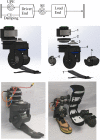Design and preliminary verification of a novel powered ankle-foot prosthesis: From the perspective of lower-limb biomechanics compared with ESAR foot
- PMID: 38848334
- PMCID: PMC11161064
- DOI: 10.1371/journal.pone.0303397
Design and preliminary verification of a novel powered ankle-foot prosthesis: From the perspective of lower-limb biomechanics compared with ESAR foot
Abstract
A novel powered ankle-foot prosthesis is designed. The effect of wearing the novel prosthesis and an energy-storage-and-return (ESAR) foot on lower-limb biomechanics is investigated to preliminarily evaluate the design. With necessary auxiliary materials, a non-amputated subject (a rookie at using prostheses) is recruited to walk on level ground with an ESAR and the novel powered prostheses separately. The results of the stride characteristics, the ground reaction force (GRF) components, kinematics, and kinetics in the sagittal plane are compared. Wearing the powered prosthesis has less prolongation of the gait cycle on the unaffected side than wearing the ESAR foot. Wearing ESAR or proposed powered prostheses influences the GRF, kinematics, and kinetics on the affected and unaffected sides to some extent. Thereinto, the knee moment on the affected side is influenced most. Regarding normal walking as the reference, among the total of 15 indexes, the influences of wearing the proposed powered prosthesis on six indexes on the affected side (ankle's/knee's/hip's angles, hip's moment, and Z- and X-axis GRF components) and five indexes on the unaffected side (ankle's/knee's/hip's angles and ankle's/hip's moments) are slighter than those of wearing the ESAR foot. The influences of wearing the powered prosthesis on two indexes on the unaffected side (knee's moment and X-axis GRF component) are similar to those of wearing the ESAR foot. The greatest improvement of wearing the powered prosthesis is to provide further plantarflexion after reaching the origin of the ankle joint before toe-off, which means that the designed powered device can provide further propulsive power for the lifting of the human body's centre of gravity during walking on level ground. The results demonstrate that wearing the novel powered ankle-foot prosthesis benefits the rookie in recovering the normal gait more than wearing the ESAR foot.
Copyright: © 2024 Liu et al. This is an open access article distributed under the terms of the Creative Commons Attribution License, which permits unrestricted use, distribution, and reproduction in any medium, provided the original author and source are credited.
Conflict of interest statement
The authors have declared that no competing interests exist.
Figures










Similar articles
-
Is biomechanical loading reduced in individuals with unilateral transtibial amputation during fast-paced walking when using different ankle/foot prostheses? A pragmatic randomized controlled trial.Prosthet Orthot Int. 2025 Apr 1;49(2):148-158. doi: 10.1097/PXR.0000000000000395. Epub 2024 Oct 29. Prosthet Orthot Int. 2025. PMID: 39486009 Free PMC article. Clinical Trial.
-
Benefits of an increased prosthetic ankle range of motion for individuals with a trans-tibial amputation walking with a new prosthetic foot.Gait Posture. 2018 Jul;64:174-180. doi: 10.1016/j.gaitpost.2018.06.022. Epub 2018 Jun 11. Gait Posture. 2018. PMID: 29913354
-
Effects of a powered ankle-foot prosthesis on kinetic loading of the unaffected leg during level-ground walking.J Neuroeng Rehabil. 2013 Jun 7;10:49. doi: 10.1186/1743-0003-10-49. J Neuroeng Rehabil. 2013. PMID: 23758860 Free PMC article.
-
Prosthetic push-off power in trans-tibial amputee level ground walking: A systematic review.PLoS One. 2019 Nov 19;14(11):e0225032. doi: 10.1371/journal.pone.0225032. eCollection 2019. PLoS One. 2019. PMID: 31743353 Free PMC article.
-
Advances in Powered Ankle-Foot Prostheses.Crit Rev Biomed Eng. 2018;46(2):93-108. doi: 10.1615/CritRevBiomedEng.2018025232. Crit Rev Biomed Eng. 2018. PMID: 30055526 Review.
References
MeSH terms
LinkOut - more resources
Full Text Sources
Medical

